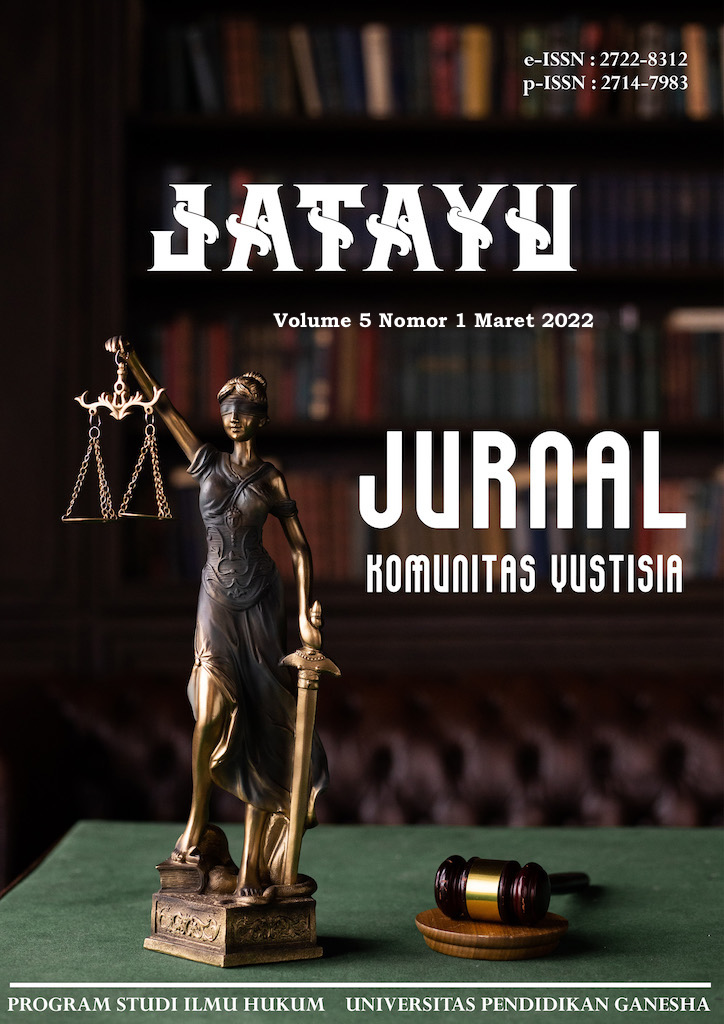PERLINDUNGAN HUKUM TERHADAP WARGA NEGARA INDONESIA (WNI) DI AFGHANISTAN BERDASARKAN KONVENSI WINA 1961 DAN KONVENSI WINA 1963 (STUDI KASUS AMBIL ALIH AFGHANISTAN OLEH KELOMPOK TALIBAN)
DOI:
https://doi.org/10.23887/jatayu.v5i2.51838Keywords:
Perlindungan Hukum, Warga Negara Indonesia, Ambil alih kekuasaan, dampak konflik, Konvensi Wina 1961 & 1963.Abstract
Penelitian ini bertujuan untuk (1) Agar dapat mengetahui dan mengkaji pengaturan mengenai hubungan diplomatik dan konsuler yang memuat tentang perlindungan hukum bagi Warga Negara Asing (WNA) yang tinggal di suatu negara (2) Agar dapat mengetahui dan mengkaji bentuk perlindungan hukum suatu negara yang mengalami konflik terhadap Warga Negara Asing (WNA) berdasarkan Konvensi Wina 1961 dan Konvensi Wina 1963 (Studi kasus Warga Negara Indonesia pada kasus ambil alih kekuasaan Afghanistan oleh kelompok taliban). Jenis penelitian yang digunakan adalah penelitian hukum normatif, dengan jenis pendekatan peraturan perundang-undangan, pendekatan konseptual, dan pendekatan historis. Sumber bahan hukum yang digunakan adalah Hukum Diplomatik dan Konsuler. Teknik pengumpulan bahan hukum yang digunakan adalah dengan cara library research atau studi kepustakaan dengan menelaah kerangka normatif serta teknik studi dokumen menggunakan bahan-bahan hukum yang memuat tentang hukum diplomatik dan konsuler. Hasil penelitian menunjukan bahwa (1) Upaya untuk memberikan perlindungan Warga Negara Indonesia (WNI) merupakan bentuk pelaksanaan tugas serta fungsi dari perwakilan diplomatik dan konsuler yang telah diatur dalam pasal 5 Ayat (1) Poin (a) Konvensi Wina 1963 serta Pasal 3 Ayat (1) Poin b dan c Konvensi Wina 1961 (2) Perlindungan hukum represif yang dapat dilakukan adalah memberikan bantuan hukum dalam bentuk konsultasi hukum dan bantuan kemanusiaan. Perlindungan hukum preventif yang dapat dilakukan adalah memberikan upaya perlindungan secara politis dan kerjasama dengan organisasi atau lembaga lembaga Internasional dengan melakukan perundingan serta membuat suatu perjanjian.
Downloads
Published
Issue
Section
License

This work is licensed under a Creative Commons Attribution-ShareAlike 4.0 International License.
Authors who publish with this journal agree to the following terms: Authors retain copyright and grant the journal right of first publication with the work simultaneously licensed under a Creative Commons Attribution License that allows others to share the work with an acknowledgement of the work's authorship and initial publication in this journal. Authors are able to enter into separate, additional contractual arrangements for the non-exclusive distribution of the journal's published version of the work (e.g., post it to an institutional repository or publish it in a book), with an acknowledgement of its initial publication in this journal. Authors are permitted and encouraged to post their work online (e.g., in institutional repositories or on their website) prior to and during the submission process, as it can lead to productive exchanges, as well as earlier and greater citation of published work (See The Effect of Open Access). Authors who publish with this journal agree to the following terms: Authors retain copyright and grant the journal right of first publication, with the work [SPECIFY PERIOD OF TIME] after publication simultaneously licensed under aCreative Commons Attribution License that allows others to share the work with an acknowledgement of the work's authorship and initial publication in this journal. Authors are able to enter into separate, additional contractual arrangements for the non-exclusive distribution of the journal's published version of the work (e.g., post it to an institutional repository or publish it in a book), with an acknowledgement of its initial publication in this journal. Authors are permitted and encouraged to post their work online (e.g., in institutional repositories or on their website) prior to and during the submission process, as it can lead to productive exchanges, as well as earlier and greater citation of published work (See The Effect of Open Access).






